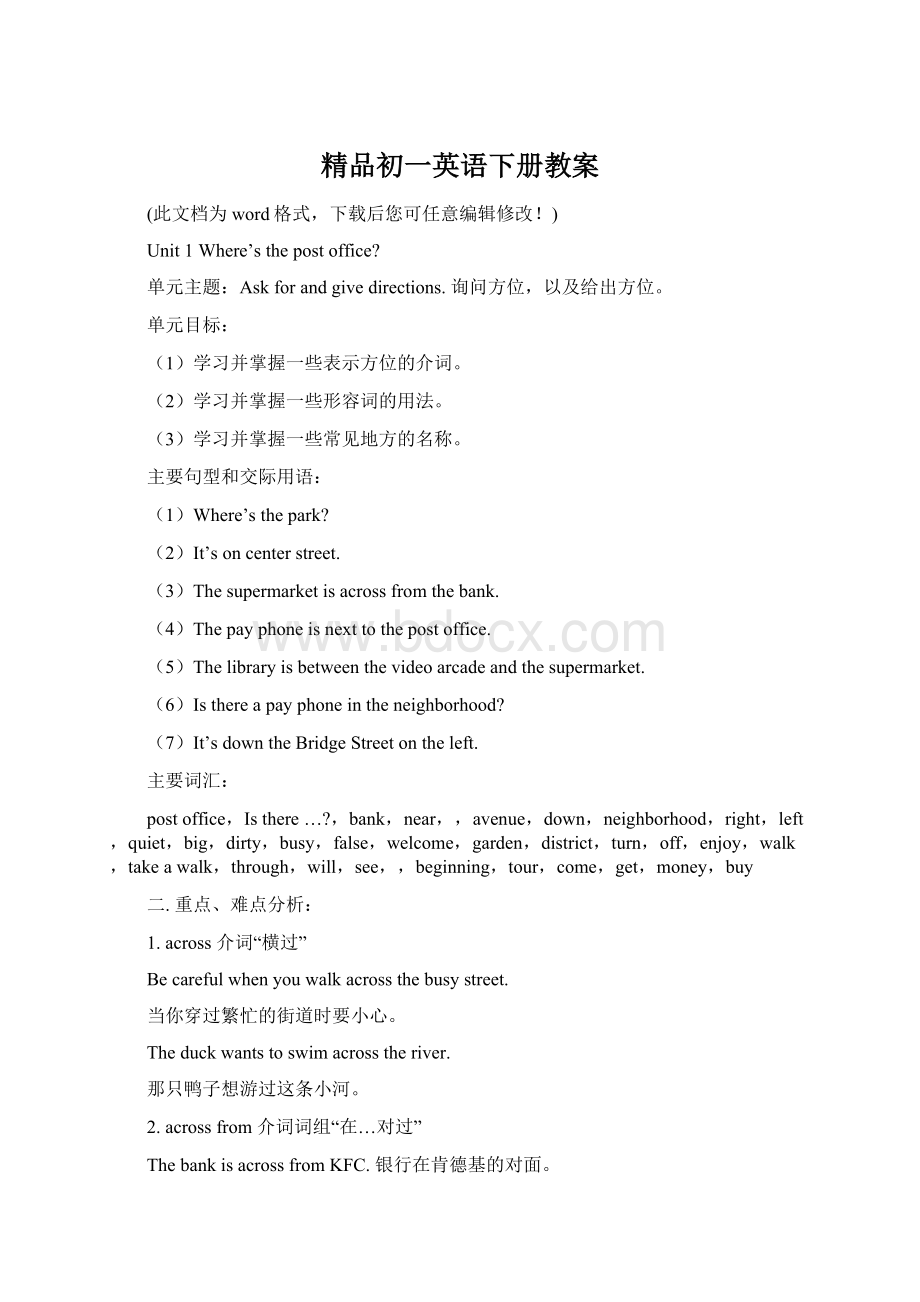 精品初一英语下册教案文档格式.docx
精品初一英语下册教案文档格式.docx
- 文档编号:18607466
- 上传时间:2022-12-29
- 格式:DOCX
- 页数:69
- 大小:71.48KB
精品初一英语下册教案文档格式.docx
《精品初一英语下册教案文档格式.docx》由会员分享,可在线阅读,更多相关《精品初一英语下册教案文档格式.docx(69页珍藏版)》请在冰豆网上搜索。

那家饭馆在国家图书馆的对面。
3.nextto“在…旁边”
Thesupermarketisnexttotheflowershop.
超市在花店的旁边。
Thesmallgardenisnexttoourschool.
4.on“在…”
ThesupermarketisonFifthAvenue.
超市在第五大街。
ThepayphoneisonBridgeStreet.
公用电话在桥街。
5.between介词“在两者之间”
Thepostofficeisbetweenthelibraryandthecinema.
邮局在图书馆和电影院之间。
ThepayphoneisbetweenthesupermarketandthebankonCenterStreet.
公用电话在中央大街上的超市和银行之间。
6.down介词“沿着;
顺着”
Thelibraryisdownthisstreetontheright.
图书馆在这条街的右侧。
Godownthisstreet,you’llfindthebank.
沿着这条街走,你就会找到那家银行。
7.ontheleftright“在左边右边”
注意介词要用on
8.Isthere…?
Isthere是Therebe句型的一般疑问句,表示“某处有某物吗?
”
e.g.Isthereapostofficenearyourneighborhood?
在你们的社区有一个超市吗?
Aretheremanyshopsinthisdistrict?
这个区域内有很多商店吗?
注意:
如果是Isthere…?
回答用Yes,thereis.No,thereisn’t.
如果是<
spanlang=EN-US
教案示例
PeriodI
教学目标:
1、掌握表示地点的词汇;
2、掌握where引导的特殊疑问句;
3、能够简单地描述地点方位;
4、能够画出简单的示意图。
教学向导:
语言目标
学习策略与思维技巧
重点词汇
表示地点的词汇
where引导的特殊疑问句
个体、群体思维;
看图作答;
交换信息;
Postoffice;
library;
;
on;
nextto;
acrossfrom…
语言结构
语言功能
跨学科学习
Therebe句型
Where句型的问答
询问路线
指出方位
通过绘画激发学生学习兴趣
教学过程设计:
Steps
Teacher’sactivity
Students’activity
Preparation
Brainstorm
Lookatsomepicturesandknowthewordsoftheseplaces
Lookandreadandlearn
Ppt.
TaskIpairwork:
Isthere….
Aim
Use‘therebe’sentences,familiarwiththenewwords
1
Readandmatchthenewwordsin1a
Readandfinishthework
Picture
2
Showthetargetlanguage:
Isthereabanknearhere?
Lookatthesentenceandtheanswer
3
AskSstotalkabouttheplacesinthepicture
Pairworktotalkabouttheplacesandstreets
Pairwork
4
Movearoundtheroomandgivesupportasneeded
Talktoeachother
5
Askpairsofstudentstoshowtheirworks
PairsofSsshowtheirworks
Checkouttheconversations
TaskIIListeningcomprehensions
Familiarwiththeprepositionsinthesentences
Lookatthepicturein2aandexplaintheprepositions
Lookandlearn
Writeontheblackboard
Listentothetapefortwotimes
Fillintheblanksandknowthemeaning
Recorder
Writedowntheanswer
Checktheanswerandpointoutthemistakes
Checktheanswers
TaskIIIgroupwork:
ourschool
Usethetargetlanguageandfamiliarwithourschoolandplaces
TeachsomemorewordstotheSsandread
Learnthenewwords
Pictures
AskSstodrawapictureofourschoolandtointroduceit
Drawthepicture
Discussingroupsandfinishthepicture
AskSstoshowtheirworksandtalkaboutit
Introducetheirworks
TaskIVpairwork:
talkaboutthepictures
Use‘where’question,andknowhowtoanswerit.
Targetlanguage:
whereisthebank?
Learnthesentences
AskSstotalkaboutthepictures
Pairworktotalkabouttheplaces
Ss’picturesorthepicturein1a
Discussinpairsand
AskSstoshowtheirworksandperformit
Showtheconversationwiththepicture
Homework
Drawapictureofyourneighborhoodandwriteashortpassagetointroduceit
教后一得:
本单元的主题是方位,地点名词是学生单词突破的重点,与学生的生活相结合,扩充一些词汇,明确的表述各个建筑所处的位置。
围绕这几点设置了四个活动,利用多媒体素材,以任务型的教学模式来完成整个教学。
其中图片的展示能给学生更立体的感受,更加明确空间位置关系。
运用画图的辅助形式,激发学生的兴趣,能够达到更好的效果。
UNIT2Whydoyoulikekoalabears?
Textanalysis:
Topic:
animalsinthezoo
Functions(Teachingaims):
1.Describeanimals2.Expresspreferencesandgivereasons
Structures:
1.Why,What,Wherequestions2.Because3.Adjectivesofquality
Whydotheylikekoalabears?
Becausethey’recute.They’rekindofshy.They’reverybig.
Vocabulary:
1.zoo,animals,tiger,elephant,koalabears,dolphin,panda,lion,penguin,giraffe2.smart,cute,fun,ugly,intelligent,friendly,shy,kindof3.SouthAfrica
Recycling:
beautiful,small,quiet,scary,interesting,Australia,Japan,Brazil,China.
Heisfrom--She’sfiveyearsold.
Learningstrategies:
1.Usingwhatyouknow2.Inferringcontent
Multi-intelligence:
1.Knowthenature2.Knowledgeofplaces3.logicalexpressions
Periods:
six
Period1sectionA1a1b1c
Period2sectionA2a2b2cGrammarfocus
Period3sectionA3a3b4
Period4sectionB12a2b3
Period5sectionB3a3b3c4
Period6selfcheck
Period1Contentsonp7
Teachingaims:
Learnnewwords:
animals—tiger,koalabear,elephant,dolphin,panda,lion,penguin,giraffedescriptionwords—cute,fun,smart
Listenandcheck(√)theanimals.
Practicetheconversation:
describeanimals
Teachingmethods:
listenandsay,readandwrite
Teachingprocedures:
Step1Presentation(1a)
Wearegoingtolearnthenamesofsomemoreanimals.
Showtheanimalsonthemapofthezoo→pointtotheanimalsandsaythenames→letstudentsreadthewords→matchthewordswiththeanimalsinthepicture→practicethewords(readandwrite)
Step2Listeningpractice(1b)
Pointtotheanimalsin1aandaskstudentstosaythenames→playtherecordingoftheconversationtwice→check(√)thenamesofanimals
Step3Pairwork(1c)
Practicetheconversationsusingthedescriptionwords.
A:
Let’sseethelions.
B:
Whydoyouwanttoseethelions?
Becausethey’recute.
Step4Consolidation:
Freetalk
Askstudentstopresenttheirconversationstotheclass.
Step5Summary:
wordsandconversations
Step6Homework:
rememberthewordsandconversations.
在课堂上,教师是参与者,帮助者,学生是活动的主体,学生的任务是开放的。
学生以小组为单位进行活动,在较真实的语境中锻炼口头、笔头能力。
有利于培养学生的合作精神,促进学科之间的渗透和交融。
Period2contentsonp8
Listeningpractice:
writethenamesoftheanimals
Oralpractice:
Askandanswerquestionsaboutanimals.
Grammarfocus
Teachingdifficulty:
differencebetweenthewordsveryandkindof.
listenandsay
Step1Revision:
Canyousaythenamesoftheanimals?
Asksomestudentstosayandtwostudentstowriteontheblackboard.
Step2Freetalk:
Makingaconversationinpairs,talkingaboutanimals.
Step3Presentation(2a)
Doyouwanttogotothezoo?
JuliaandHenryaretalkingabouttheanimalsinthezoo.Let’slistentogether.
Playtherecordingtwice→studentswriteinthenamesoftheanimals→drawalinebetweenanimalsandadjectives
Step4Listeningpractice(2b)
Heartherecordingagain→completetheconversationswiththewordsgiven→tellthewords:
very&
kindof(Theyalwayscomejustbeforetheadjectivesinthesentences.Lookatthecartoonsunder2b.Wecanmakesure.Anotherexample:
ifwearefamiliarwithpercentages,wemightusethefollowingscaletotheirmeaning:
0%50%95%
notkindofvery)
Step5Pairwork(2c)
Practicethetargetlanguage.
Askandanswerquestionswiththegivenwords.
Step6Consolidation:
asksomepairstoactouttheconversations.
Step7Summary:
GrammarFocus
Step8p9
Saythenamesofthecountriesonthemaps.
Talkaboutwheretheanimalscomefrom.
Game:
Bingo.
Keypoints:
Countries:
China,Australia,SouthAfrica,Japan,Brazil.
Animals:
lions,pandas,koalabears,dolphins,elephants,giraffes.
Usethegeographyknowledgetomatchthecountriesandanimals;
playthegame—bingo.
Teachingaids:
tape,recorder,maps,usecoins,paperchipsorscrapsofpaperasmarkers.
Teachingprocedure:
freetalk
Workinpairs,describingtheanimals.
Step2Presentation
Wemanymoreanimals.Doyouwanttoknowwheretheanimalsarefrom?
Let’slookatthemapsandsaythenamesofthecountries(showthemaps).
Pointtothemapsandaskstudentstosaythenames→pointtotheanimalsin3aandaskstudentstonamethem→ask:
Wherearetheanimalsfrom?
→Letthestudentsdrawalinebetweeneachanimalandthecountry.
Step3Pairwork(3b)
Wherearelionsfrom?
They’refromAfrica.(Usetheanimalsandcountriesinactivity3a.)
Step4Game:
Bingo(4)
Readthecountriesandtheanimalsinthebox→writeninewordsfromtheboxonthebingoboard→listentothetape→crossout(X)thewordsyouplaceamarkeroneachword.→say“bingo”whenyougetarrowofXsorcoverthreeboxesinarow.
Accordingtothegame,wecanconsolidatetheanimalsandcountries.
Wep10
Rememberthedescriptionwords:
ugly,intelligent,friendly,cute,shy.
Listeningpractice
talkaboutanimals.
intelligent,friendly,cute,shy
Whydoyouwanttoseelions?
Step2Presentation
Wewordssuchasscary,interesting,small,cute,exciting.We’lllearnfourdescriptionwordsthisclass:
ugly,intelligent,friendly,shy.
Step4Matchthewordsandtheanimals.
(1)
Lookthepicturesin1→askastudenttosaythenamesofanimals→readt
- 配套讲稿:
如PPT文件的首页显示word图标,表示该PPT已包含配套word讲稿。双击word图标可打开word文档。
- 特殊限制:
部分文档作品中含有的国旗、国徽等图片,仅作为作品整体效果示例展示,禁止商用。设计者仅对作品中独创性部分享有著作权。
- 关 键 词:
- 精品 初一英语 下册 教案
 冰豆网所有资源均是用户自行上传分享,仅供网友学习交流,未经上传用户书面授权,请勿作他用。
冰豆网所有资源均是用户自行上传分享,仅供网友学习交流,未经上传用户书面授权,请勿作他用。


 对中国城市家庭的教育投资行为的理论和实证研究.docx
对中国城市家庭的教育投资行为的理论和实证研究.docx
![ISO-8501[1].1-2007-涂装表面清洁度的目视评定-(中文译本).doc](/Images/s.gif)